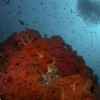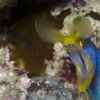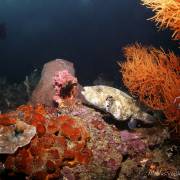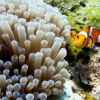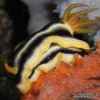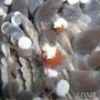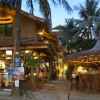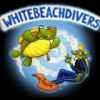Dive in Boracay
-
Yapak Boracay, Philippines
Yapak 1 and 2 are actually two separate walls which begin at 30 meters and drop down to 70 meters. The most famous of Boracay’s dive sites, close encounters with white tip and grey reef sharks, dogtooth tuna, groupers, napoleon wrasses and giant trevallies are common. Surface conditions can be… -
Angol Point Boracay, Philippines
This is an excellent dive site for beginners and training dives. The reef is covered with stony corals, leather corals, nudibranchs, anemones, sea stars and sea cucumbers. It is also a favourite for night dives and is a good spot for macro photography. Good for snorkelling, too. -
Camia II Boracay, Philippines
The Camia II, once a steel hulled fishing vessel, was sunk in January 2000. It rests on the bottom at 30 meters with its wheel house at 20 meters. It has since developed very nicely as an artificial reef. The sealife include large red bass, bluefin trevallies, scorpion fish, school of batfish,… -
Balinghai Boracay, Philippines
Balinghai is two walls running parallel to each other. The deep wall features sharks and tuna while the shallow wall is pockmarked by small holes which house anthias, lionfish, triggerfish, bannerfish, puffers and gobies. -
Friday's Rock Boracay, Philippines
A dive at Friday’s can actually cover two dive sites: Friday’s Reef which is 7 to 12 meters, and Friday’s Rock which is 12 to 18 meters. This famous fish-feeding station is a large boulder which provides photographers a chance to capture close-up shots of emperors, triggerfish, red bass,… -
Tribird Boracay, Philippines
TribirdTribird is a plane wreck which was sunk on purpose by the Boracay Acossiation of Scuba Schools. It was sunk in February 2012 to create a new dive site. since it is very new there are not too many corals growing on the plane yet, but since it is in the middle of a reef system you have a lot of… -
Coral Garden Boracay, Philippines
This dive site is right off the main beach and usually has calm and clear conditions. It is ideal for beginners and training dives. It is a popular fish-feeding area, so expect to see sergeant majors, butterflyfish and batfish crowding around. A favourite snorkelling spot. -
Bat Cave Boracay, Philippines
This dive site is a series of small caves leading to the actual Bat Cave which is also accessible by land. Conditions must be just right to dive here, since waves usually pound against the rocks and swift currents can take you offshore. Lobsters, sea snakes and of course, the bats overhead can make… -
Camia Wreck Boracay, Philippines
The Camia is Boracay’s house wreck. It is a 30 metre-long cargo boat that was sank as a Fish Attraction Device in January 2001. It has since developed very nicely as an artificial reef. The residents now include a couple of huge red bass, some bluefin trevallies, scorpion fish and a school of… -
Channel Steps Boracay, Philippines
Strong tidal currents flow through the strait, taking divers on a joy ride through canyons and crevices. Coral growth here is very impressive and occasionally white tip sharks and trevallies are sighted. Great site for drift diving. Photography is not possible due to high current's velocity - images… -
Crocodile Island Boracay, Philippines
From a distance, this small uninhabited island looks like the head of a crocodile. Currents can be fierce except at slack tide, which makes for a beautiful collection of corals. It is a gently sloping wall with several canyons and caves containing a wide diversity of fish. -
Laurel Islands Boracay, Philippines
Big Laurel and Small Laurel are two separate dive sites which are very similar and quite close to each other. Big Laurel has a tunnel swim-through (8m wide) filled with soft corals and nudibranchs. Both Laurels are sloping walls with healthy corals and prolific fish life. -
Beach Night Dive Boracay, Philippines
The beach is a little-known treasure trove for divers with a sharp eye. It is a sandy area with patches of sea grass and hard corals. Watch out for flounders, crabs, nudibranchs, squid and pipefish. -
Laguna de Boracay Boracay, Philippines
This dive site is located on the “backside” (east side) of Boracay. It is well-suited for beginners and professionals alike, with a great diversity of clams, anemones, feather stars, butterflyfish, lionfish and sea squirts. The area is quite large, and almost every inch is covered with hard and… -
Punta Bunga Boracay, Philippines
This site is the start of a series of walls which connect to Yapak. The drop-off is filled with cubbyholes where moray eels, lionfish, groupers and triggerfish reside. Stingrays are usually seen on the sandy bottom at 24 meters. -
Tulobhan Reef Boracay, Philippines
Although it is quite shallow, a slow steady current usually allows drift diving to cover a wide area. Sea snakes are common, while sea cucumbers, eels and feather stars can be seen waving in the current. -
Virgin Drop Boracay, Philippines
This wall dive is ideal for deep dive training. Large sea fans and crinoids provide colourful hiding spots for bass, moray eels and nudibranchs. Rays are sometimes seen gliding through the thermoclines during tidal changes.
